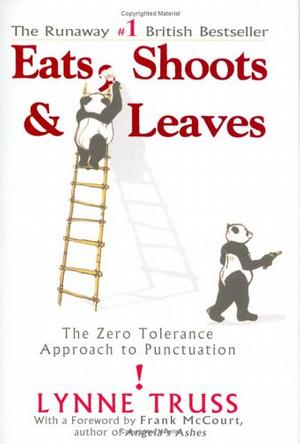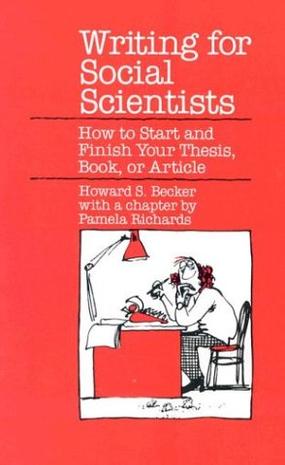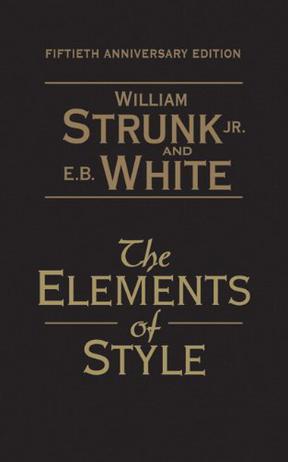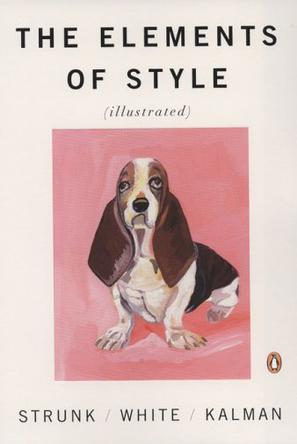-

Eats, Shoots & Leaves
"Eats, Shoots & Leaves" has sold over 3 million copies world-wide. This illustrated version for children shows how the humble comma can change the meaning of a sentence completely. You might want to eat a huge hot dog, but a huge, hot dog would run away pretty quickly if you tried to take a bite out of him. 'Children Drive Slowly' on a road-sign doesn't quite sum up what kids do in their spare time. And we all know now that the comma in 'Eats shoots and leaves' is a crucial one. Lynne Truss and Bonnie Timmons illuminate the hilarious confusion that one mere dot with a tail can cause, in this follow-up to the number one best-seller "Eats, Shoots & Leaves" - which this time features lively and subversive pictures by one of America's leading illustrators. This picture book is sure to elicit gales of laughter and better punctuation from all who read it. -

Writing for Social Scientists
Social scientists, whether earnest graduate students or tenured faculty members, clearly know the rules that govern good writing. But for some reason they choose to ignore those guidelines and churn out turgid, pompous, and obscure prose. Distinguished sociologist Howard S. Becker, true to his calling, looks for an explanation for this bizarre behavior not in the psyches of his colleagues but in the structure of his profession. In this highly personal and inspirational volume he considers academic writing as a social activity. Both the means and the reasons for writing a thesis or article or book are socially structured by the organization of graduate study, the requirements for publication, and the conditions for promotion, and the pressures arising from these situations create the writing style so often lampooned and lamented. Drawing on his thirty-five years' experience as a researcher, writer, and teacher, Becker exposes the foibles of the academic profession to the light of sociological analysis and gentle humor. He also offers eminently useful suggestions for ways to make social scientists better and more productive writers. Among the topics discussed are how to overcome the paralyzing fears of chaos and ridicule that lead to writer's block; how to rewrite and revise, again and again; how to adopt a persona compatible with lucid prose; how to deal with that academic bugaboo, "the literature." There is also a chapter by Pamela Richards on the personal and professional risks involved in scholarly writing. In recounting his own trials and errors Becker offers his readers not a model to be slavishly imitated but an example to inspire. Throughout, his focus is on the elusive work habits that contribute to good writing, not the more easily learned rules of grammar and punctuation. Although his examples are drawn from sociological literature, his conclusions apply to all fields of social science, and indeed to all areas of scholarly endeavor. The message is clear: you don't have to write like a social scientist to be one. -

Writing for Social Scientists
Social scientists, whether earnest graduate students or tenured faculty members, clearly know the rules that govern good writing. But for some reason they choose to ignore those guidelines and churn out turgid, pompous, and obscure prose. Distinguished sociologist Howard S. Becker, true to his calling, looks for an explanation for this bizarre behavior not in the psyches of his colleagues but in the structure of his profession. In this highly personal and inspirational volume he considers academic writing as a social activity. Both the means and the reasons for writing a thesis or article or book are socially structured by the organization of graduate study, the requirements for publication, and the conditions for promotion, and the pressures arising from these situations create the writing style so often lampooned and lamented. Drawing on his thirty-five years' experience as a researcher, writer, and teacher, Becker exposes the foibles of the academic profession to the light of sociological analysis and gentle humor. He also offers eminently useful suggestions for ways to make social scientists better and more productive writers. Among the topics discussed are how to overcome the paralyzing fears of chaos and ridicule that lead to writer's block; how to rewrite and revise, again and again; how to adopt a persona compatible with lucid prose; how to deal with that academic bugaboo, "the literature." There is also a chapter by Pamela Richards on the personal and professional risks involved in scholarly writing. In recounting his own trials and errors Becker offers his readers not a model to be slavishly imitated but an example to inspire. Throughout, his focus is on the elusive work habits that contribute to good writing, not the more easily learned rules of grammar and punctuation. Although his examples are drawn from sociological literature, his conclusions apply to all fields of social science, and indeed to all areas of scholarly endeavor. The message is clear: you don't have to write like a social scientist to be one. -

The Elements of Style
You know the authors’ names. You recognize the title. You've probably used this book yourself. And now The Elements of Style –the most widely read and employed English style manual–is available in a specially bound 50th Anniversary Edition that offers the title's vast audience an opportunity to own a more durable and elegantly bound edition of this time-tested classic. Offering the same content as the Fourth Edition, revised in 1999, the new casebound 50th Anniversary Edition includes a brief overview of the book's illustrious history. Used extensively by individual writers as well as high school and college students of writing, it has conveyed the principles of English style to millions of readers. This new deluxe edition makes the perfect gift for writers of any age and ability level. Fifty Years of Acclaim for The Elements of Style , by William Strunk Jr. and E.B. White I first read Elements of Style during the summer before I went off to Exeter, and I still direct my students at Harvard to their definition about the difference between 'that' and 'which.' It is the Bible for good, clear writing.”-- Henry Louis Gates Jr. “For writers of all kinds and sizes the world begins and ends with Strunk and White’s Elements of Style . Only something to actually write abouttrumps the list of what is required to put words together in some kind of coherent way. I treasure its presence in my life and salute its fifty years of glory and accomplishment."-- Jim Lehrer “ The Elements of Style remains an unwavering beacon of light in these grammatically troubled times. I would be lost without it.” -- Ann Patchett "To the extent I know how to write clearly at all, I probably taught myself while I was teaching others -- seventh graders, in Flint, Michigan, in 1967. I taughtthem witha copy of Strunk & White lying in full view on my desk, sort of in the way the Gideons leave Bibles in cheap hotel rooms, as a way of saying to the hapless inhabitant: ‘In case your reckless ways should strand you here, there's help.’ S&W doesn't really teach you how to write, it just tantalizingly reminds you that there's an orderly wayto go about it, that clarity's ever your ideal, but -- really -- it's all going to be up to you." -- RichardFord “ The Elements of Style never seems to go out of date. Its counsel is sound and funny, wise and unpretentious. And while its precepts are a foundation of direct communication, Strunk and White do not insist on a way of writing beyond clear expression. The rest is up to the imagination, the intelligence within.” -- David Remnick, editor of The New Yorker “It’s the toughness–the irreverence and implicit laughter–that attracted me to the little book when I was seventeen. I fell in love with Strunk & White’s loathing for cant and bloviation, the ruthless cutting of crap, jargon, and extra words. For me, that skeptical directness included a tacit permission by The Elements of Style to break its rules on occasion: an alloy of generosity in the blade, a grace I still admire and still learn from.” -- Robert Pinsky “In the quest for clarity, one can have no better guides than Strunk and White. For me, their book has been invaluable and remains essential.” -- Dan Rather "Eschew surplusage! A perfect book."--Jonathan Lethem "Not until I started teaching writing and I reread The Elements of Style did I realize that most everything I would be teaching young writers, and everything I would be learning myself as a writer, was contained between the covers of this slim, elegant, wise little book. -- Julia Alvarez “Strunk and White seared their way into my brain long ago, and I benefit from them daily.” -- Steven J. Dubner, co-author of Freakonomics “Since high school, I have kept a copy of this book handy. That should be unnecessary. I should, by now, have fully internalized The Elements of Style . But sometimes I get entangled in a paragraph that refuses to be ‘clear, brief, bold.’ I dip back into The Elements of Style and am refreshed. After Scott Simon interviewed me on NPR about whether the word ‘e-mail’ needs a hyphen (yes, it does), some listeners, including friends of mine, wondered why I had answered in the affirmative when asked, in passing, ‘Are you a drunken white man?’ Those listeners misheard. ‘Strunk and White man’ was what Scott said.” -- Roy Blount Jr. “Strunk & White--writing's good-natured law firm--still contains enough sparkling good sense to clean up the whole bloviating blogosphere." -- Thomas Mallon “I used Strunk -- that’s what we called it, Strunk -- as a student at Berkeley fifty years ago. I didn't know that it was new, and that we were the first generation to be educated in The Elements of Style . I got a firm foundation in the English language, learned to write basically, and could depict the realistic world.Then I was able to become an impressionist and expressionist.” -- Maxine Hong Kingston “Strunk and White's gigantic little book must be the most readable advice on writing ever written. Side by side with Roget, Shakespeare, the Bible, and adictionary, it's an essential forevery writer's shelf.” -- X.J. Kennedy... 美国大学校园人手一册的英语语法书籍。 -

Clear and Simple As the Truth
Everyone talks about style, but no one explains it. The authors of this book do; and in doing so, they provoke the reader to consider style, not as an elegant accessory of effective prose, but as its very heart. At a time when writing skills have virtually disappeared, what can be done? If only people learned the principles of verbal correctness, the essential rules, wouldn't good prose simply fall into place? Thomas and Turner say no. Attending to rules of grammar, sense, and sentence structure will no more lead to effective prose than knowing the mechanics of a golf swing will lead to a hole-in-one. Furthermore, ten-step programs to better writing exacerbate the problem by failing to recognize, as Thomas and Turner point out, that there are many styles with different standards. In the first half of "Clear and Simple", the authors introduce a range of styles - reflexive, practical, plain, contemplative, romantic, prophetic, and others - contrasting them to classic style. Its principles are simple: The writer adopts the pose that the motive is truth, the purpose is presentation, the reader is an intellectual equal, and the occasion is informal. Classic style is at home in everything from business memos to personal letters, from magazine articles to university writing. The second half of the book is a tour of examples - the exquisite and the execrable - showing what has worked and what hasn't. Classic prose is found everywhere: from Thomas Jefferson to Junichiro Tanizaki, from Mark Twain to the observations of an undergraduate. Here are many fine performances in classic style, each clear and simple as the truth. -

The Elements of Style
The only style manual ever to appear on bestseller lists has explained to millions of readers the basic principles of plain English. The book's mantra-make every word tell-is still on point. Whether seventeen or seventy, this much-loved classic, now in its fourth edition, will forever be the go-to guide when in need of a hint on how to make a turn of phrase clearer, or a reminder on how to enliven prose with the active voice. Kalman's exquisite illustrations give the revered work a jolt of new energy, making the learning experience more colorful and clear. The Elements of Style Illustrated will come to be known as the definitive, must-have edition.